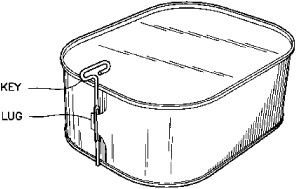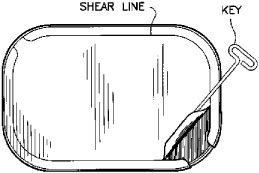
INVENTOR: James William Black
Berwick, Nova Scotia
(Patent No. CA 24,012, July 5, 1886)
James William Black invented a syrup for making a refreshing beverage called Ice Cream Soda. The ingredients were whipped egg whites, sugar, water, lime juice, lemons, tartaric acid or citric acid, flavouring extract, and bicarbonate of soda. The ingredients were combined in this concentrated form and bottled. According to the inventor, a beverage of ice cream soda was readily mixed by placing a small ladle of the syrup in a drinking glass and filling the glass with ice water, which produced a beautiful drink, creamy and foaming at the top.

INVENTOR: Gilbert W. Ganong
St. Stephen, New Brunswick
(Patent No. CA 33,108, February 28, 1889)
As part of a marketing initiative, Gilbert W. Ganong of Ganong Bros. Ltd. invented a process for imprinting the letters GB on the bottom of individual chocolates. Each candy was dipped into melted chocolate, cream, or other confectionery and then placed upon the embossed or engraved letters or designs on a flexible mold plate and left there to dry. When hard, the chocolates were removed, with the design or letters of the mold plate now fully impressed upon them. The owners of Ganong Bros. Ltd. also invented the chicken bone, a hard candy jacket over a chocolate centre, in 1885. They invented the world’s first chocolate nut bar in 1910. The company was the first in Canada to make lollipops (1895); the first in Canada to use cellophane in packaging (1920); the first to make chocolate peppermint rolls (1926); and the first in Canada to sell Valentine candy in heart-shaped boxes (1932).

INVENTOR: Joseph Sutton Clark
St. George, New Brunswick
(Patent No. CA 68,455, August 13, 1900)
This invention is the earliest of the key-opening cans, in which the side of the can overlaps and ends in a lip or lug to which a key is attached to open the can. The inventor’s disclosure also contains instructions for making flat cans. In that case, a seam is provided as close to the upper edge of the can as possible, in order to keep any liquid from spilling when the can is opened. Cans of this type are still used as containers for many foods, such as corned beef, ham, and other luncheon meats.

INVENTOR: James Rooney
Kentville, Nova Scotia
(Patent No. CA 119,276, July 6, 1909)
This invention provided a perforated receptacle with a plunger inside a tea or coffee pot for containing tea leaves or coffee grounds, allowing them to be easily removed after infusion. A similar concept is still in use today.

INVENTOR: Hartley A. Wentworth
Deer Island, New Brunswick
(Patent Nos. CA 209,501, March 15, 1921; CA 333,890, July 11, 1933;
CA 378,373, December 13, 1938; CA 401,447, December 16, 1941)
Hartley A. Wentworth recognized the value of fish liver and fish oil as a food supplement, particularly for their high vitamin A and D content. He developed various processes for extracting and preparing fish liver, fish oils, and cod liver oil. Patent No. CA 333,890 illustrates Wentworth’s commitment to improving nutrition. It describes a process for preparing a food supplement of fresh raw fish liver mixed with chocolate. This product was developed with the cooperation of another inventor from the area, Whidden Ganong of Ganong Bros. Ltd. Their objective was to make a food supplement that would be acceptable to children.

INVENTOR: George F. Humphrey
Bridgetown, Nova Scotia
(Patent Nos. CA 245,230, December 9, 1924; CA 275,794, November 29, 1927)
George F. Humphrey held the pioneer patents on breakfast foods containing fruits mixed with cereal products. He was the first to introduce into a breakfast food a natural fruit that imparted a distinct fruity flavour to the finished product and made it more nutritious.
Humphrey’s first patent describes a method for producing a cold breakfast food. The fruits are cooked and reduced to pulp, and the pulp is dried, sweetened, and placed in a mixing and kneading machine. Cereal flour, such as wheat flour, is added to the fruit pulp, together with a solution of yeast and water, and the ingredients are mixed to create a uniform dough. The dough is cooked and passed through flaking rollers. The flakes are roasted in an oven, dried, cooled, and packed and sealed in containers for distribution. The second patent describes a process for producing a hot fruit and cereal breakfast food that would be cooked in the same manner as oatmeal. The process consisted of mixing an uncooked granulated cereal with an uncooked fruit pulp and then dehydrating the materials.

Humphrey’s preferred fruit for the cold breakfast food was apples, because of their abundance and their nutritive value. He said, “The apple furnishes mineral salts and organic acids so necessary to the human system, and also vegetable albumens which promote and assist digestion.” In the oatmeal-type breakfast food, Humphrey said, certain fruits could be used with certain cereals to create a variety of distinct flavours, such as oranges with corn meal and peaches with wheat semolina.
Because of George F. Humphrey’s patents, breakfast foods such as Kellogg’s Raisin Bran, Kellogg’s Apple Crisp Müslix, and Kellogg’s Banana Nut Müslix became obvious and thus unpatentable in a broad manner.
INVENTOR: Henry T. Austin
Blacks Harbour, New Brunswick
(Patent No. CA 321,222, April 5, 1932)
The success of the sardine industry is attributable, to some degree, to the invention of a container that is a convenient size for carrying in a lunch box, holds enough sardines for a pleasant snack, and can be opened with a simple key that is detachable from the container. A number of inventors from southwestern New Brunswick, the home of Connors Bros. Ltd., the largest sardine plant of its kind in the world, contributed over time to the ultimate development of Henry T. Austin’s sardine can, illustrated here.

INVENTORS: Walter H. Boutilier, Halifax, Nova Scotia,
and Frank W. Bryce, Montreal, Quebec
(Patent No. CA 386,404, January 23, 1940)
The frozen fish fillet was invented in Halifax around 1926. Fourteen years later, Walter H. Boutilier and Frank W. Bryce went one step further. Their patent describes a product consisting of raw fish impregnated with a flavouring substance, in which the fish is dipped prior to freezing. The patent also gave the inventors the exclusive right to the process of immersing fish in a low-temperature bath of a suitable flavouring substance and then subjecting it to quick freezing.
